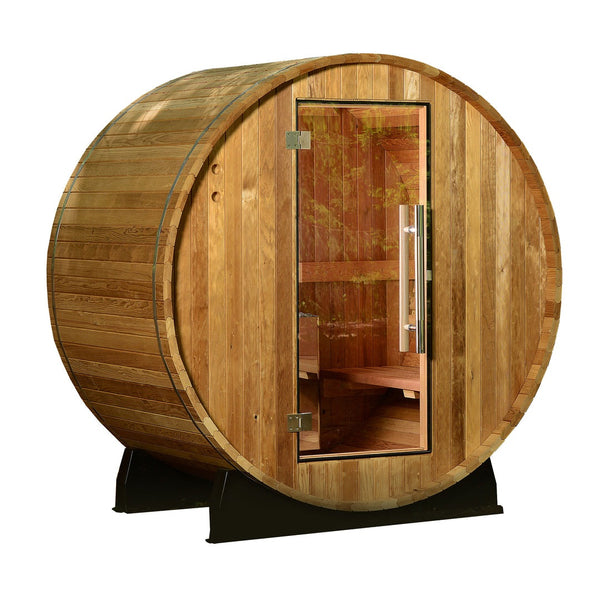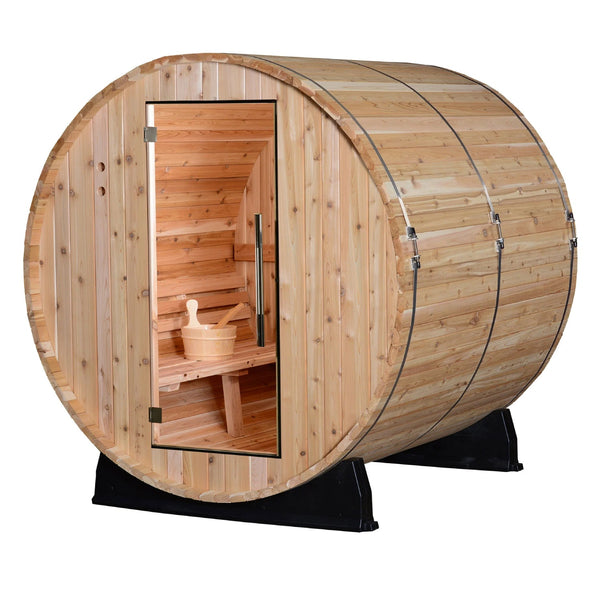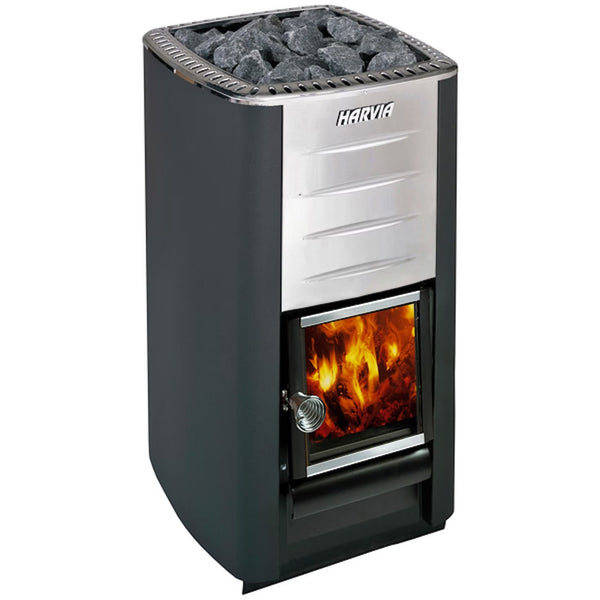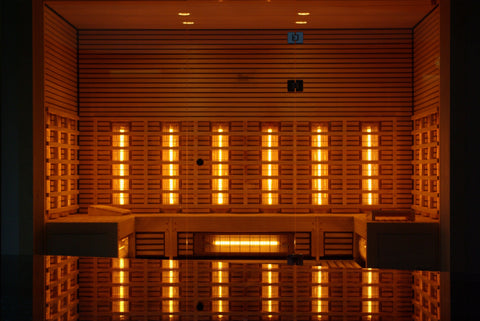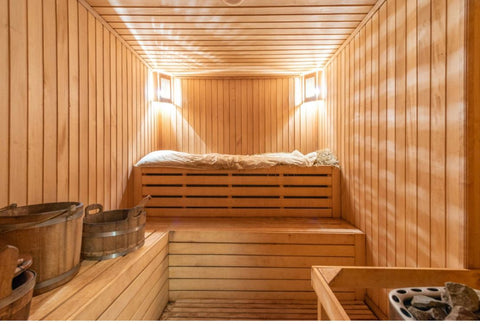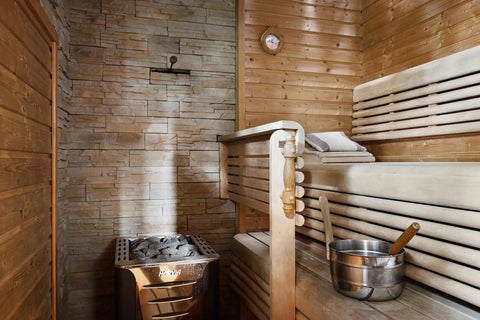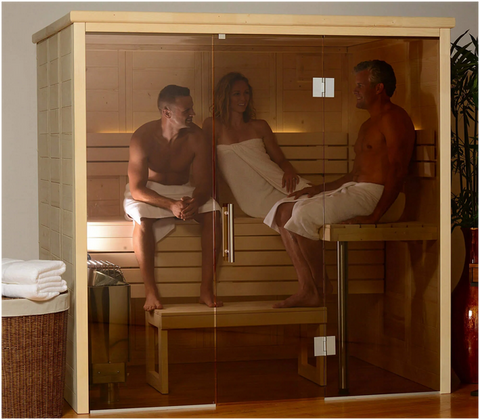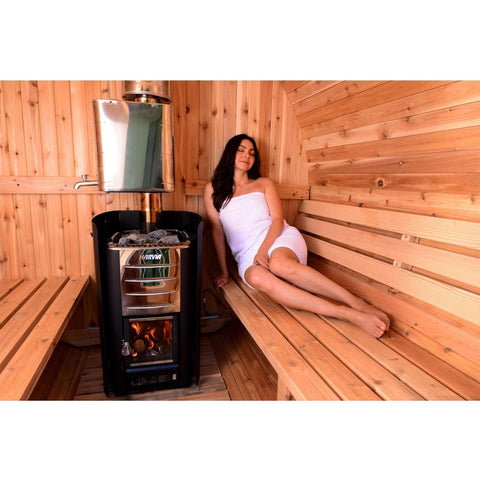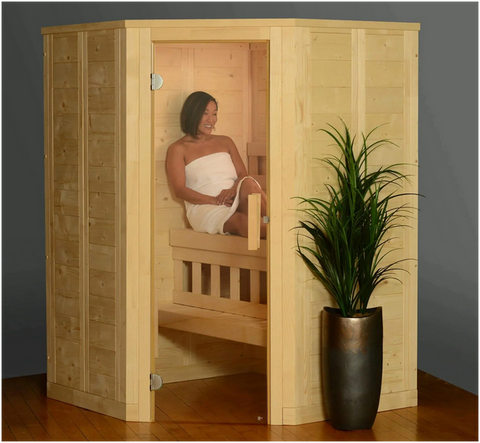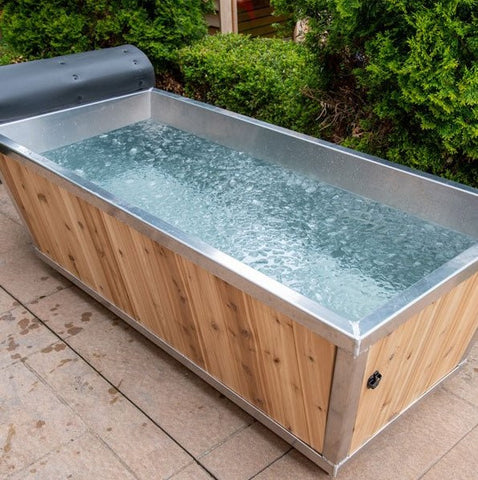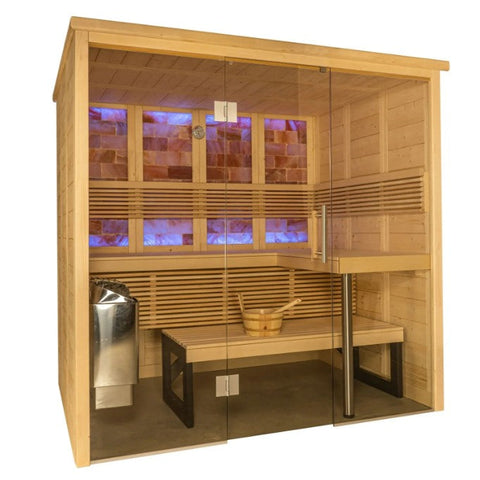
Ever heard of a sauna or a steam room? In movies or TV shows, we see people coming out of these rooms looking admittedly sweaty and sticky, but also healthy!
These heat therapy spaces can be found in most gyms or fitness centers, and sometimes in your home too. Plenty of studies back the health benefits of both rooms since ancient times, both physically and even mentally.
But what are these benefits? Do the health benefits differ between a sauna and a steam room?
Let’s find the key differences between a steam room and a sauna and find out which one fits your needs.
What Is a Sauna?
A sauna is essentially a warm room with temperatures ranging from 70–90 degrees Celsius, though the heat usually depends on the user. Originating from Finland, they’re typically considered spaces for relaxation and health. As mentioned, you can find one in most gyms, but in homes, it can be found as part of a bathroom or a separate cottage.
The heat in a sauna can be dry or wet, depending on the type, and visiting a sauna usually involves a cycle of warming the body and then cooling down through a shower, pool, or even a lake dip.
Traditional Sauna vs. Infrared Sauna
Today, there’s a wide variety of sauna options. Traditional saunas, especially the Finnish variety, are known for their high temperatures and dry heat (less than 20% humidity). A traditional sauna typically uses a wood-burning stove or an electric heater to warm up the stones inside.
For example, the HUUM Drop 9 kW Electric Sauna Heater is efficient and looks amazing in any traditional sauna.
Humidity can be controlled by throwing water onto these heated rocks to produce steam, so users can choose to have a wet or dry sauna experience.
Infrared saunas, on the other hand, use light waves. An infrared sauna often uses lower temperatures at around 45–65 degrees Celsius. A far infrared sauna penetrates deep into the body to activate sweat glands, while a near infrared sauna focuses on cellular regeneration. These more modern saunas are quite popular in health clubs and spas.
Unlike a traditional sauna, an infrared sauna often doesn’t have any humidity, since there’s no steam. These saunas are often designed to heat one’s body instead of the air.
What Is a Steam Room?
A steam room is an enclosed space heated with steam. Unlike a sauna, the steam in these rooms is from a steam generator or a boiler system. This creates the moisture in the air.
Traditional steam rooms often have a temperature of around 38–43 degrees Celsius with high humidity levels, usually around 95 percent to 100 percent.
What Is the Difference Between a Steam Room and a Sauna?
Saunas and steam rooms can be quite similar, especially in terms of the health benefits they offer. But they do have key differences.
Below is a table showing the main differences between a steam room and a sauna:
|
Characteristics |
Steam Rooms |
Saunas |
|
Temperature |
38–43 ºC |
70–95 ºC |
|
Humidity |
Nearly 100% |
10% no water, 60% with water |
|
Environment |
Larger communal spaces |
More compact, fewer people |
|
Heat Type |
Moist, humid conditions |
Usually dry heat |
|
Material used |
Glass, tile, and/or plastic |
Often wood, except for infrared saunas |
|
Cultural Origin |
Often associated with Turkish baths |
Attributed to Finnish culture |
The temperature shown in the table is generally what’s recommended, but it may vary depending on your needs.
|
Fast Facts: People say they sweat more in steam rooms, but the droplets on their bodies are more from the condensed water from the humid air than it is their perspiration. |
What Are the Health Benefits of a Sauna?

Saunas are great for most people—they provide a myriad of benefits:
Promotes Heart Health
Having reduced stress levels when sauna bathing may positively affect your cardiovascular health. A study conducted in Finland, done over the course of 20 years, suggested that those who use a sauna regularly have a lower risk of dying from cardiovascular diseases.
Improves Blood Pressure
Having a sauna bath will temporarily increase your heart rate and blood pressure, similar to a simple exercise. Doing so regularly may lower blood pressure and reduce the risk of hypertension.
Supports Workout Recovery
There’s a reason why a lot of people use a sauna post-workout. The heat in the sauna increases body temperature, which helps with blood circulation. Improved circulation then speeds up the body’s natural healing process, thus minimizing the soreness and pain we may feel after a particularly intense workout.
Eases Joint Pain
Regular sauna bathers with rheumatoid arthritis and other similar diseases see improvement in the pain they feel and their range of motion. People with chronic pain even notice an increase in their quality of life when they regularly use a sauna.
Reduces Stress
Another of the better-known benefits of using a sauna is stress reduction. Sauna baths reduce the production of cortisol, the body’s stress hormone.
Lowers Risk of Dementia and Alzheimer’s Disease
The same study conducted in Finland also showed that those who used a sauna two to three times per week were 22 percent less likely to get dementia and 20 percent less likely to get Alzheimer’s than those who don’t. The percentage jumps to 66 and 65 percent respectively when people get a sauna bath four to seven times a week.
This should be taken with a grain of salt, though, as it wasn’t proven in the study that it was the sauna that caused the reduction.
Helps with Mental Wellness
There have been studies that show how using a sauna can help with depression and anxiety. Regularly using a sauna helps increase people’s appetites and relaxation, reduces feelings of frustration and anxiety, and even protects against psychotic disorders.
Improved sleep
An increase then a drop in our core body temperature may trick our brain into thinking it’s time to go to sleep. An hour or two in the sauna right before going to bed may help restore our body’s circadian rhythm.
|
Sauna Myth: Many sites may claim that sweating in saunas helps remove toxins from the body. Unfortunately, no scientific research backs up this claim. |
What Are the Health Benefits of a Steam Room?
Steam rooms offer similar health benefits to those of a sauna. In addition to those mentioned above, a steam room can offer the following:
Relieves Respiratory Issues
Steam rooms help clear congestion in the respiratory tract. The steam helps loosen phlegm and mucus, which makes it easier for us to breathe. It’s a great way to improve the health conditions of people prone to sinusitis or the common cold.
However, though steam therapy may provide temporary relief, it has not been scientifically proven to be an effective treatment.
Improves Skin Health
The humid environment of a steam room opens up pores, which may help eliminate any dirt or toxins trapped underneath your skin. The condensation then will rinse away the dirt and dead skin.
Hydrates the Skin
The warm, damp air in steam rooms will drench your skin in moisture. Properly moisturized skin improves its elasticity and overall appearance and makes it feel soft and smooth.
Steam Room vs. Sauna: Which Is Better for My Health?

Both steam rooms and saunas are designed to raise our core body temperatures, so choosing which one depends on your needs and preferences and how your body reacts to the heat of either room. Some people may prefer the dry heat, while others prefer higher humidity levels (or “moist heat”).
The high temperatures in saunas may offer faster recovery benefits after workouts and aid in muscle relaxation and reducing soreness.
Select Saunas has revolutionized the sauna experience by offering a wide range of sauna options. We offer traditional saunas and infrared saunas.
In terms of skincare, steam rooms may offer a slight edge, given that the steam helps open pores and hydrates the skin. Select Saunas also offers steam generators along with the necessary accessories.
Are There Any Risks Associated with a Sauna or Steam Room?
While there are plenty of benefits associated with both rooms, people using or planning to use either room should be aware of certain risks and use each one with caution.
Due to thermal stress on both saunas and steam rooms, people run the risk of dehydration. It’s best not to spend longer than 10 minutes inside and to drink plenty of water afterward. Overheating is also a risk, particularly for those not accustomed to high temperatures. Some people might also get dizzy or lightheaded, leading to falls or other injuries inside the rooms.
The warm, humid environment of both rooms, though particularly for steam rooms, is also the perfect environment for certain bacteria and germs to thrive and spread, so there’s also the risk of getting skin infections like athlete’s foot.
The following people should also avoid using any heat therapy rooms unless they’ve consulted their doctor and are given the all-clear:
- People with very low or high blood pressure
- Pregnant people
- Children
- People who are immuno-compromised or with worsening health conditions like heart disease, epilepsy, respiratory diseases, etc.
- People who’ve taken stimulants or tranquilizers
- People who drink alcohol or are intoxicated
- People recovering from surgery
|
Heat Therapy Myth: Using a sauna or a steam room regularly will help you lose weight—though true, the weight you’ve lost after a bath is your water weight, not fat. You’ll gain the weight back when you eat or drink. |
Frequently Asked Questions
Can you use a sauna and steam room on the same day?
Yes, generally people use a sauna first and then a steam room, but this is not a hard and fast rule. Use either one in whatever order you prefer.
Just remember to hydrate in between using either room and monitor how you feel during and after each session. If you start experiencing symptoms like a racing heart or dizziness, it's a sign to stop.
How long should you stay in a sauna? Steam room?
Beginners can use a sauna or a steam room for 5–10 minutes for two to three times a week. Once they’re accustomed to the heat and observe no adverse effects, they can bump this up to 15–20 minutes.
Should you use a sauna or steam room for weight loss?
Using a sauna or steam room may help with temporary weight loss—but this is from the loss of your body water. However, with a good exercise plan and a balanced diet, saunas or steam rooms can help you burn calories through sweating. Infrared saunas can even burn through 400–600 calories within 30 minutes.
Conclusion
If you’re still on the fence about which one you should use, your preferences matter. Both steam rooms and saunas offer plenty of health benefits as long as you’re aware of the risks and use either one both carefully and responsibly.
Remember to consult your doctor before trying either one out, and immediately stop if you feel dizzy, overheated, generally unwell, or have an abnormally fast heart rate even after exiting the sauna or steam room.



